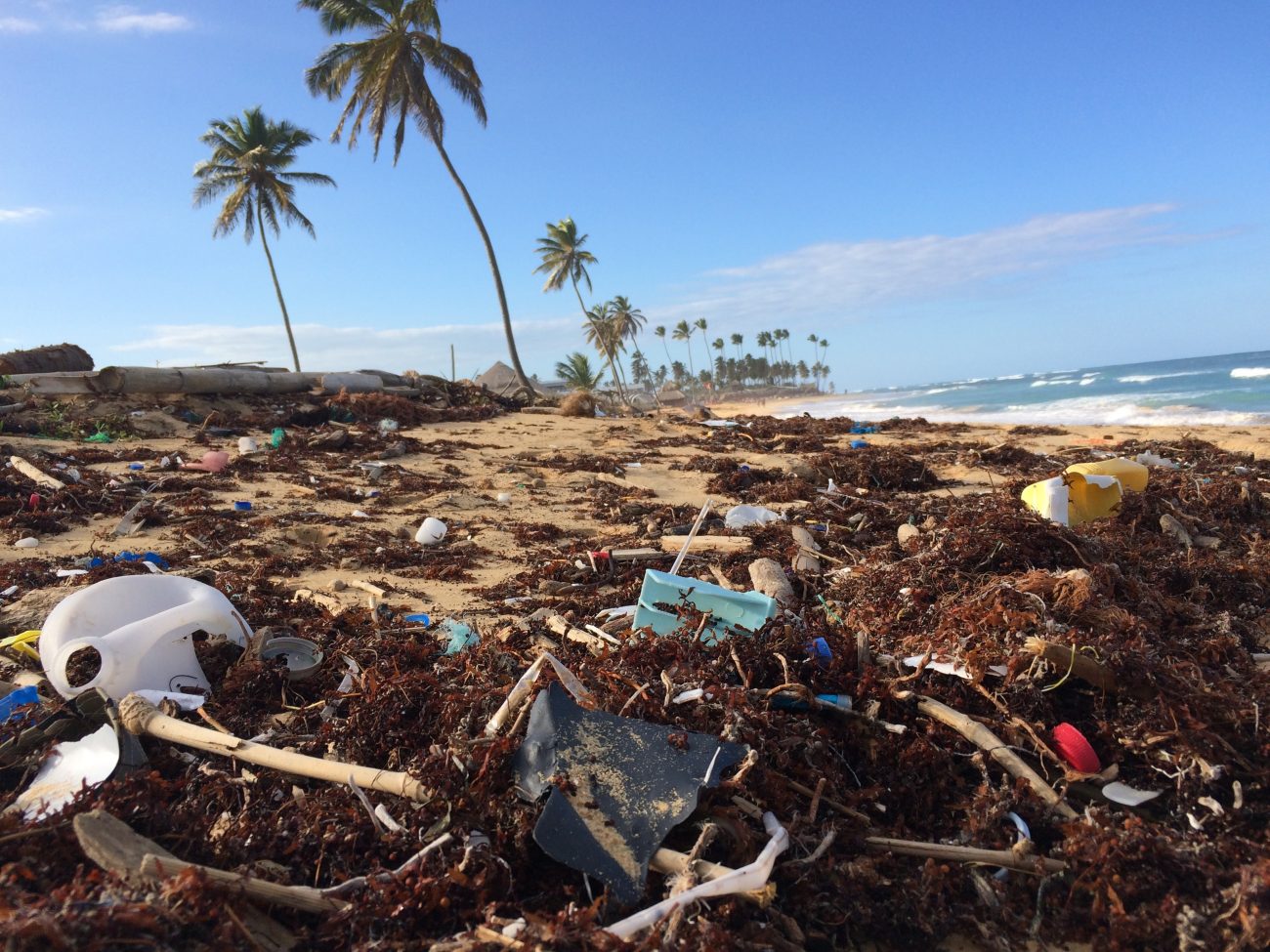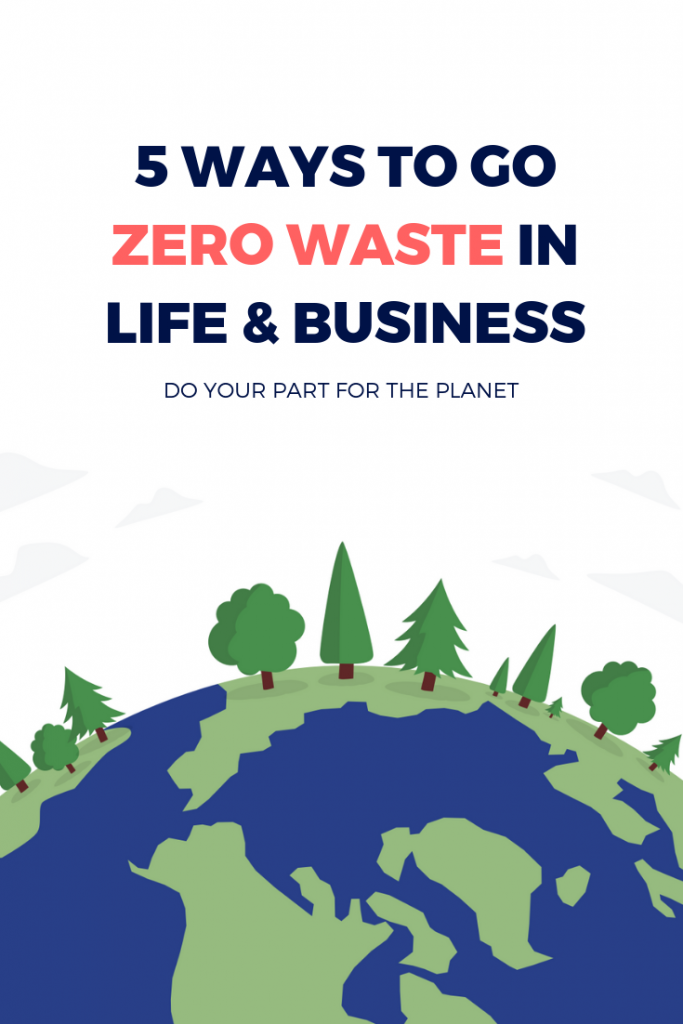When I tell people that our family of four is on track to take our trash bin to the curb just once per year, they usually pause for a second and then say, “I don’t have time to reduce my trash like that.”
The truth is, reducing your trash is easier than it sounds—you may not get down to one bin per year, but there are a lot of easy ways to cut back.
And as soon as I started making personal changes, I immediately realized that I could apply the same concepts to my business. As I started to share my progress with my clients through social media, they were so excited. It showed me that clients really do care that we’re doing what we can to bring sustainability into our businesses.
The first thing to consider is plastic. If you’ve watched “A Plastic Ocean” on Netflix, you know that plastic pollution has become a major problem for our planet.

Quick Stats on Going Zero Waste:
- 91% of plastic isn’t recycled.
- The ocean is likely to have more plastic than fish by 2050.
- Emissions associated with plastics are projected to make up almost one sixth of global emissions by the middle of this century.
So what can we do about all of this waste as individuals and small business owners?
After reading the book Zero Waste Home by Bea Johnson, I started making small personal changes day-by-day. I highly recommend starting this as a personal journey and using what you’ve learned to slowly adapt your business practices.
5 Ways to Reduce Your Waste:
1. Refuse What You Don’t Need
In your personal life, this might be as simple as asking for your drink without a straw or reconsidering what you really need to buy. In your business, you might consider whether or not you’re allowing your customers to “opt out” of getting the stuff that they may not need.
For example, if you manage events and always give out “swag,” consider allowing event attendees to opt out of the swag bag before it’s ever produced.
If you’ve always made a habit of giving out gifts or other freebies as a part of your business, consider the full lifecycle of the items that you’re giving away. Can they be recycled, consumed, or composted when the end user is done? Is it necessary?
Go paperless with HoneyBook and we'll plant you a tree
You can save 2.5 trees, 938 gallons of water and 12.15 cubic feet of landfill space EVERY YEAR just by going paperless in your business. HoneyBook makes it easy with online invoices, online contracts, brochures and proposals. Go paperless with HoneyBook. Take part in Earth Day 2019 this Monday, April 22. Subscribe before Monday, and we’ll plant a tree in your name. GET HONEYBOOK
Start free trialIf you run a restaurant or manage events, could you remove straws unless customers ask for them? Or offer reusable metal straws for the people who do request them?
If you’re a florist, could you differentiate your business by eliminating foam or other disposables from your designs? There are always customers out there looking for green options, but they may be struggling to find companies who can provide them with sustainable choices.
2. Reduce the Waste for What You Do Need
One of our biggest personal changes came in the form of grocery shopping. We went beyond bringing our shopping bags to the store. We now use bags to replace as much plastic as possible—we use our own bags for fruit, vegetables, bulk coffee beans, granola, sugar, flour, chocolates, and anything that we can find unpackaged in the bulk section of our local grocery store.
We also aim to buy package free as much as possible—we switched to unpackaged solid shampoo, conditioner, soap, and deodorant bars.
If you’re using disposables as a part of your business, consider how you might be able to swap them out for reusables. Or at the very least—see if you can buy things locally to avoid the packaging that goes along with your shipments. This will also help you to support other businesses in your local area.

3. Reuse
We’ve slowly replaced the disposables in our home with reusables:
- Paper napkins and paper towels are replaced with cloth napkins and towels.
- Ziplock bags are replaced with Stasher silicone bags and metal bento boxes.
- Cling wrap is replaced with reusable beeswax.
- Disposable coffee mugs are replaced with our own travel mugs or porcelain mugs (I’ve never been turned down when I ask a coffee shop to use my travel mug, and if you’re “dining in,” it’s easy to ask for a real mug).
- Take out containers are replaced with our own bento boxes.
Disposable makeup wipes are replaced with cloth makeup wipes.
This also applies to buying secondhand instead of new, or repairing what’s broken rather than throwing it away for something new.
Reusing materials in your own business and buying secondhand will likely save you money in the long run, and as the global movement to reduce single use plastics continues, your customers will appreciate the changes.
4. Recycle
Every city has different recycling policies, and many cities have stopped recycling, so your best bet is to start by refusing, reducing, and reusing, but you can also make a point to buy products in packaging that can be more easily recycled.
For example, we switched to dish detergent and laundry pods in cardboard, and we try to seek out plastic-free packaging as much as possible.
If you produce products, consider switching your packaging to something that’s easier to recycle.
If your business does a lot of shipping, consider swapping plastic shipping containers for paper, and even plastic tape for paper tape.
If your business has a storefront, you might also consider setting up TerraCycle bins to help your community recycle otherwise difficult to recycle items. This is a great way to bring more locals into your store while doing something good for your community.
As a photographer, I purchased a TerraCycle zero waste bin to recycle any materials associated with my photo products that would otherwise go in the trash.
5. Rot (Compost)
According to the EPA, food waste makes up 22% of discarded solid waste. We started by composting our own food waste at home with a Bokashi bin and traditional outdoor composter, and then we started to seek out compostable materials for household items like chapstick, bandaids, and floss.
If you run a business related to food or florals, consider where your waste ends up. Could you be composting your wood waste or flowers rather than adding them to the landfill? As a restaurant owner, could you offer compostable takeout containers while also encouraging people to use their own reusable containers? If you produce products, does it make sense to look into compostable packaging?
Reducing the waste in your life and business will take some time. Take small steps—do what you can with what you have.
I’ve found so much joy in aligning my actions with my values. I hope you will too.
April 22 is Earth Day, and we would love to see how you’re reducing waste in your life and business. Feel free to tag us @risingtidesociety and @honeybook so we can share the inspiration with our world-changing community.



